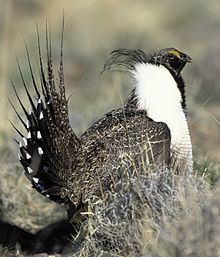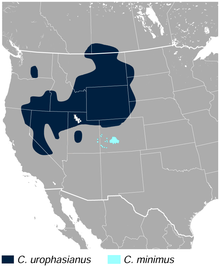Sage grouse
| Sage-grouse | |
|---|---|
 |
|
| Adult male greater sage-grouse | |
| Scientific classification | |
| Kingdom: | Animalia |
| Phylum: | Chordata |
| Class: | Aves |
| Subclass: | Neornithes |
| Superorder: | Galloanserae |
| Order: | Galliformes |
| Family: | Tetraonidae (disputed) |
| Genus: |
Centrocercus Swainson, 1832 |
| Species | |
 |
|
| Sage and Gunnison Grouse ranges | |
The sage-grouse are the two species in the bird genus Centrocercus. They are the largest grouse from temperate North America. Adults have a long, pointed tail and legs with feathers to the toes. As in most Galliformes, there is pronounced sexual dimorphism.
Conservation issues, related to US military funding, has raised the profile of the animal in 2014–2016.
The specific epithet is from another Greek word, "oura", plus "phasianos", pheasant. The noun "pheasant" was originally applied to a bird that was native to the valley of the Phasis River (now the Rioni River), which is located in Georgia. In the time of Lewis and Clark the word "pheasant" stood for "a genus of gallinaceous birds", according to lexicographer Noah Webster (1806), and the explorers often used it in that sense. "Gallinaceous" then referred to "domestic fowls, or the gallinae"; the family Galliformes (Latin "gallus", cock, and "forma", shape) now includes pheasants, grouse, turkeys, quail, and all domestic chickens.
Sage Grouse are also collectively known as sagehen, sage grouse, sage cock, sage chicken or cock of the plains.
Lewis and Clark were credited with the "discovery" of five gallinaceous birds in addition to the sage grouse: the Columbian sharp-tailed grouse, the dusky grouse, Franklin's grouse, the Oregon ruffed grouse, and the mountain quail.
In September 2016, the National Defense Authorization Act (NDAA) was stalled in Congress of the United States of America because the Republican Majority Leader Kevin McCarthy, of California, indicated he will not let the annual NDAA proceed to a vote in the House of Representatives unless it contains language to bar the sage grouse from the federal endangered species list until at least 2025. President Barack Obama threatened a veto over the issue, that Senate Armed Services Committee Chairman, John McCain, believes would be sustained. Current US Air Force spending on sage grouse conservation is around US$200,000, with eight known military installations having confirmed grouse populations: Dugway Proving Ground and Tooele Army Depot in Utah; Sheridan Training Area and Camp Guernsey in Wyoming; Hawthorne Army Depot and Nellis Air Force Base in Nevada; Yakima Training Center in Washington, and Mountain Home Air Force Base in Idaho.
...
Wikipedia
